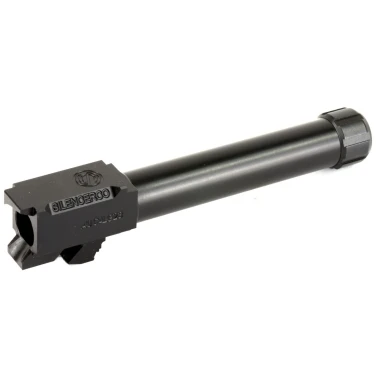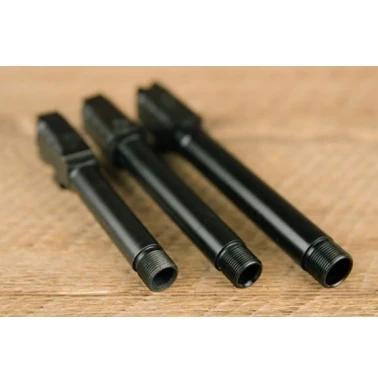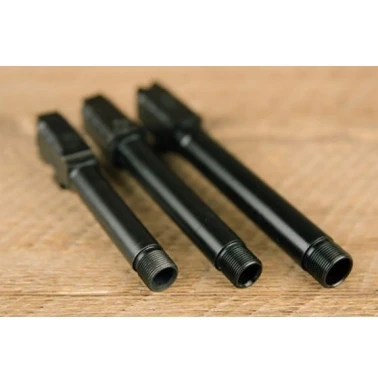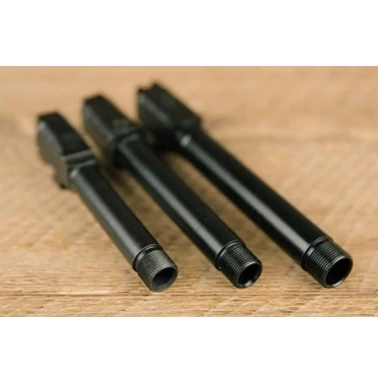A threaded barrel is a game-changing upgrade for firearm enthusiasts, offering a standardized platform to attach various muzzle devices. But what exactly is a threaded barrel, and what does a threaded barrel do for your firearm? The experts here at Silencer Shop put together this guide, detailing the process of rifle barrel threading, breaking down common thread pitches for different calibers, and explaining the benefits of using a threaded barrel versus a non-threaded barrel. We’ll also cover legal considerations, such as which states restrict threaded barrels and answer practical questions like do you need a threaded barrel for a compensator.
Whether you’re a competitive shooter, tactical training enthusiast, or recreational plinker, understanding the details of your firearm’s threading can help you optimize performance and customize your weapon system to your exact needs.
Table of Contents
What Is a Threaded Barrel and What Does It Do?
A threaded barrel is a firearm barrel with external threads, cut into its muzzle end. These threads provide a standardized mounting surface for various muzzle devices, including suppressors, muzzle brakes, compensators, and flash hiders. In essence, what does a threaded barrel do? It enables the secure attachment of accessories that can enhance your shooting experience by reducing recoil, minimizing muzzle blast, and controlling flash.
By transforming a standard barrel into a modular platform, a threaded barrel opens the door to countless customization options. Whether you want to shoot quieter with a suppressor or reduce recoil with a compensator, the threaded barrel is the first step toward achieving your desired performance.
The Process of Rifle Barrel Threading
Understanding Rifle Barrel Threading
Rifle barrel threading refers to the process of cutting precise threads into the muzzle end of a gun barrel using advanced machinery, such as a CNC lathe. This ensures a high degree of accuracy and uniformity, which is critical for the reliable attachment of muzzle devices. The threads are measured by both their diameter and their pitch, which describes the distance between each thread.
Determining Thread Size & Pitch
To ensure compatibility, you must accurately measure:
- Diameter: The width of the threaded section.
- Pitch: The number of threads per inch (TPI) for Imperial sizes or the distance between threads in millimeters for metric sizes.
For example, a common designation like 1/2x28 means the barrel has a 1/2-inch diameter with 28 threads per inch. This specification is crucial when determining if your muzzle device—whether a suppressor, compensator, or flash hider—will attach correctly.
Common Threaded Barrel Sizes and Pitches
| Caliber | Thread Sizes | Details |
|---|---|---|
| 5.56 / .223 | 1/2x28, M13x1 LH, M15x1 | 1/2x28 threaded barrels are the most common for 5.56 caliber rifles; Some Steyr AUG models use M13x1 LH threaded barrels; H&K carbines often use M15x1 threaded barrels. |
| 6.5 Creedmoor | 5/8x24, 3/4x24 | 5/8x24 is the most common thread pitch for 6.5 Creedmoor; 3/4x24 threads are sometimes found on precision rifles. |
| 7.62 / .308 | 5/8x24, M14x1LH, M24x1.5 | 5/8x24 is the most common thread pitch for 30-caliber rifles; AK-pattern rifles may use M14x1LH or M24x1.5 threaded barrels. |
| 8.6BLK / .338 | M18x1.5, 5/8x24, 3/4x24 | M18x1.5 is the most common thread pitch for 8.6BLK and .338 caliber rifles; 5/8x24 can also be found on these rifles; 3/4x24 is common on precision rifles. |
| 50 Cal | 5/8x24, 3/4x24 | 5/8x24 is the most common thread pitch, but 3/4x24 is also found on 50-caliber firearms. |
Common Rifle Thread Pitches
5.56 / .223 Barrel Thread Size
- 1/2x28 threaded barrels are the most common for 5.56 caliber rifles.
- Some Steyr AUG models use M13x1 LH threaded barrels.
- H&K carbines often use M15x1 threaded barrels.
6.5 Creedmoor Barrel Thread Size
- 5/8x24 is the most common thread pitch for 6.5 Creedmoor.
- 3/4x24 Threads are sometimes found on precision rifles.
7.62 / .308 Barrel Thread Size
- 5/8x24 is the most common thread pitch for 30-caliber rifles.
- AK-pattern rifles may use M14x1LH or M24x1.5 threaded barrels.
8.6BLK / .338 Barrel Thread Size
- M18x1.5 is the most common thread pitch for 8.6BLK and .338 caliber rifles.
- 5/8x24 can also be found on these rifles.
- 3/4x24 is common on precision rifles.
-
50 Cal Barrel Thread Size
- 5/8x24 is the most common thread pitch, but 3/4x24 is also found on 50-caliber firearms.
Common Pistol Thread Pitches
| Caliber | Thread Sizes | Details |
|---|---|---|
| 9mm | 1/2x28, M13.5x1 LH, 1/2x36 | 1/2x28 is common for 9mm handguns and rifles; European firearms often use M13.5x1 LH Threads; 1/2x36 can be found on 9mm rifles, but is less common. |
| .357 Magnum / .38 Special | 1/2x28 | Most .357 Magnum revolvers and lever action rifles are threaded 1/2x28. |
| .40SW | 9/16×24, M14.5x1 LH | 9/16×24 is the most common thread pitch for .40 cal handguns; some European firearms use M14.5x1 LH threaded barrels. |
| .45ACP | .578x28, M16x1 | .578x28 is the most common thread pitch for .45 cal handguns; H&K pistols often use M16x1 threaded barrels. |
| 5.7x28mm | 1/2x28 | 1/2x28 is the most common thread pitch for 5.7 pistols and carbines. |
9MM Barrel Thread Size
- 1/2x28 is common for 9mm handguns and rifles.
- European firearms often use M13.5x1 LH Threads.
- 1/2x36 can be found on 9mm rifles, but is less common.
357 Magnum / 38 Special Thread Size
- Most .357 Magnum recovers and lever action rifles are threaded 1/2x28.
40SW Barrel Thread Size
- 9/16×24 is the most common thread pitch for .40 cal handguns.
- Some European firearms use M14.5x1LH threaded barrels.
45ACP Barrel Thread Size
- .578x28 is the most common thread pitch for .45cal handguns.
- H&K pistols often use M16x1 threaded barrels.
5.7x28mm Barrel Thread Size
- 1/2x28 is the most common thread pitch for 5.7 pistols and carbines.
Common Rimfire Thread Pitches
| Caliber | Thread Size | Details |
|---|---|---|
| .22LR | 1/2x28 | 1/2x28 is the standard thread pitch for .22 Long Rifle pistols and rifles. |
| .22 Magnum | 1/2x28 | Most .22 Magnum firearms are threaded in 1/2x28. |
| 17HMR | 1/2x28 | 1/2x28 is the most common thread pitch for 17HMR firearms. |
.22LR Barrel Thread Size
- 1/2x28 is the standard thread pitch for .22 Long Rifle pistols and rifles.
.22 Magnum Barrel Thread Size
- Most .22 Magnum firearms are threaded in 1/2x28.
17HMR Barrel Thread Size
- 1/2x28 is the most common thread pitch for 17HMR firearms.
Threaded vs Non-Threaded Barrels: Purpose and Benefits
A non-threaded barrel is typically found on older factory firearms and does not offer the option to attach additional accessories. In contrast, a threaded barrel is designed to accept various muzzle devices that can significantly improve your firearm’s performance.
Benefits of a Threaded Barrel
A threaded barrel offers several key advantages:
- Accessory Compatibility: The primary purpose of a threaded barrel is to allow for the attachment of suppressors, compensators, muzzle brakes, and flash hiders. This makes your firearm much more versatile.
- Enhanced Shooting Experience: By enabling the attachment of devices that reduce recoil and muzzle blast, a threaded barrel can lead to improved accuracy and faster follow-up shots.
- Modularity: With a threaded barrel, you can easily swap accessories to suit different shooting conditions. Whether you need a suppressor for quiet shooting or a compensator for competitive events, a threaded barrel makes it simple.
- Competitive Edge: In competitive shooting, reducing recoil and controlling muzzle rise can mean the difference between a winning shot and a miss.
Do You Need a Threaded Barrel for a Compensator?
A common question is do you need a threaded barrel for a compensator? Generally, the answer is yes, most modern compensators are designed to attach to a threaded barrel. Without threads, there is no standardized mounting surface, which means the compensator would not function properly.
Attaching a Muzzle Brake
Muzzle brakes are designed to reduce felt recoil and muzzle rise by redirecting gases expelled from the barrel. They typically feature multiple ports or chambers that vent gases in various directions, counteracting the recoil forces. Muzzle brakes are popular among precision shooters and those using high-recoil magnum rifles or high rate of fire carbines.
Using a Compensator
Similar to muzzle brakes, compensators are designed to reduce muzzle rise and recoil. However, compensators primarily focus on mitigating muzzle rise by directing gases upward. This helps the shooter maintain better control over the firearm during rapid fire or follow-up shots. Compensators are commonly used in competition shooting and tactical applications where quick target acquisition is essential.
Installing a Flash Hider
Flash hiders are designed to reduce the visible muzzle flash generated by the combustion of propellant gases. By dispersing and cooling the gases as they exit the barrel, flash hiders help conceal the shooter's position in low-light conditions and minimize the blinding effect of muzzle flash. They are commonly used in military and law enforcement applications where stealth and concealment are critical.
Attaching a Suppressor (Silencer)
Suppressors, also known as silencers, are devices attached to the muzzle of a firearm to reduce the sound signature of the gunshot by trapping and slowing down the escaping gases. Suppressors work by utilizing internal baffles to dissipate and cool the hot gases, resulting in a quieter gunshot. They are popular among hunters, recreational shooters, and tactical operators who prioritize hearing protection, reduced noise pollution, and improved shooting comfort.
Understanding & Using Your Threaded Barrel
But muzzle devices aren’t the only things that you can attach to your threaded barrel. Let’s take a list at some other accessories and components, and how they fit into the broader picture:
Adaptors
Adapters are used to connect different components or accessories that may not directly fit together due to variations in thread size, pitch, or type. For example, you could use an adapter for 1/2x28 to 5/8x24 to attach a 30 caliber silencer to your 5.56 AR15.
Quick-Detach (QD) Mounts
QD mounts provide a convenient way to attach and detach accessories quickly and securely without requiring tools.While many muzzle devices like brakes and flash hiders can also mount a suppressor, these are thread attachments without any features except for suppressor mounting provisions. These mounts typically feature a locking mechanism that allows for rapid attachment and removal. Common QD mounts include Trilug devices for rifles and Cam-Lok devices for handguns.
Boosters/Pistons
Booster assemblies (also known as piston boosters) are components used in pistol suppressors to facilitate the cycling of the firearm's action. When a suppressor is attached to a semi-automatic pistol, the added weight can affect the gun's cycling. A booster helps counteract this by decoupling the mass of the silencer with an internal spring, allowing for reliable cycling.
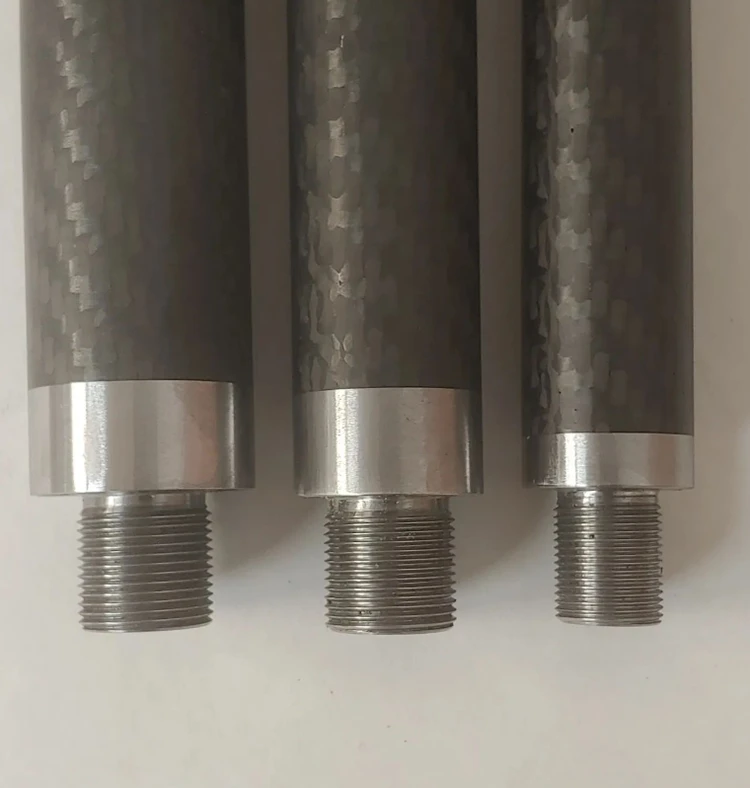

Credit: @internationalbarrels
Using Muzzle Attachments
When using threaded barrels and related accessories, it's essential to consider compatibility, proper installation, and maintenance:
- Compatibility: Ensure that all components are compatible with your firearm in terms of thread pattern, caliber, and intended use.
- Installation: Follow manufacturer instructions carefully when installing threaded barrels, adapters, QD mounts, and other accessories. Proper installation ensures safety and optimal performance.
- Maintenance: Regularly inspect and clean threaded components to prevent buildup of debris or damage that could affect performance or safety.
Additionally, always prioritize safety when handling firearms and accessories. Familiarize yourself with local laws and regulations regarding the use and ownership of threaded barrels, suppressors, and other firearm accessories.


Determining Thread Size & Pitch
Thread size of a threaded barrel for a gun is determined by two numbers:
- The diameter
- The pitch of the screw threads.
The first number is the diameter, and the second is the thread pitch (or thread size/coarseness). For example, the 1/2x28 muzzle threads for most .22 caliber firearms, including .22 LR and .223/5.56, where “1 / 2” is the diameter of the threaded section in inches (one half inch) and “x28” is the number of threads per inch of threaded section length. Having exact measurements of your threaded gun barrel is important to ensure the compatibility of your firearm and suppressor.
Thread pitch is the distance between screw threads, and this distance determines the size of the threads (also known as the coarseness or fineness of the threads). A quick online search should help determine the thread pitch of your firearm, or you can measure teh diameter and count how many threads are in a given length of threaded section.
In standard/Imperial screw sizes, we count the number of Threads Per Inch or TPI. For example, a thread size ending in “x28” has 28 threads per inch of threaded section. A higher TPI number means finer threads, as more of them are packed into that same inch of threaded section.
The measurement of your firearm may be designated in metric size, for example,
M13.5x1 LH. If you see “M”, preceding the thread size, that letter denotes Metric. With metric fasteners, the thread pitch is expressed as the distance, in millimeters, between threads (i.e. from peak to peak). For example, a metric thread size ending in “x1.5” means 1.5mm of space from thread to thread. The smaller the number, the finer the threads.
Determining whether the threads are Right Hand (RH) or Left Hand (LH) is important because this designates the direction in which the threads turn. RH is the most common thread direction for American firearms and you’ll turn clockwise to tighten (AKA “righty-tighty”). Left-hand threaded barrels turn counterclockwise to tighten and are prevalent in European manufacturing (which is also likely to use metric measurements). For example, a SIG Sauer MCX-Spear features 5/8x24 RH threads, and a Kalashnikov AK-47 uses M14x1 LH muzzle threads.
FAQs
What is the most common barrel thread?
The most common threaded barrels are 1/2x28 TPI, 5/8x24 TPI, and .578x28 TPI. Popular suppressor manufacturers (such as Dead Air, Griffin Armament, and SilencerCo) also use the threaded sizes below. The uniformity was created to standardize barrel thread sizes with barrel calibers:
1/2x28 TPI: everything up through .224 caliber (.17 HMR, .22 LR, .223/5.56, .22-250, 5.7x28, etc.) plus 9x19mm (your standard 9mm pistol ammo) and .350 Legend
5/8x24 TPI: everything over .224 caliber through .30 caliber (.243 cal, 6mm, .264 cal, 6.5mm, 6.8mm, .28 cal, 7mm, 7.62mm and .30 cal including .308 Win, 300 BLK, .300 Win Mag, etc.) plus 375 Raptor. Sometimes .450 Bushmaster, .458 SOCOM, and others will employ 5/8x24” threads.
M13.5x1 LH: some German/European 9mm pistols such as GLOCK and Sig Sauer
M14x1 LH: most AK-47s. An exception is modern, U.S.-made barrels that often use the more U.S.-standard 7.62mm 5/8x24 threads.
.578x28 TPI: most .45 ACP handguns. Also, many .40 S&W and 10mm Auto
9/16x24 TPI: common for .40 S&W and 10mm Auto as well as some large bore rifles
11/16x24 TPI and 3/4x24 TPI: used in many big bore applications, from .338 Lapua Mag up through .458 SOCOM and more. For anything over .30 caliber / 7.62mm, make sure to check with the barrel manufacturer or otherwise verify your barrel thread size.
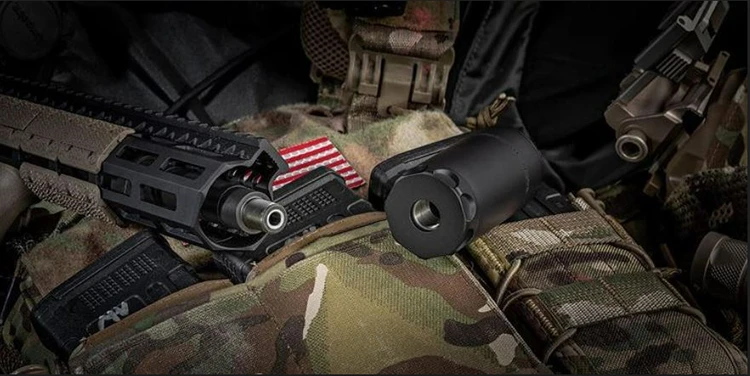

Photo credit: @Surefire_llc
How are Gun Barrels Threaded?
Gun barrels are commonly threaded by using a CNC lathe. A lathe is able to provide greater precision as opposed to threading by hand. While hand threading can be done, modern techniques and machinery have improved concentricity and consistency for threading barrels.
Where to Get Your Barrel Threaded
If your rifle does not have a threaded barrel, a qualified gunsmith should offer a barrel threading service, in the correct thread pitch for you. Many Powered by Silencer Shop dealers offer in-house gunsmithing services, such as barrel threading, muzzle device installation, suppressor alignment checking, and even pin and welding services for shorter-barreled firearms. Reach out to your local Silencer Shop dealer to get started with upgrading your favorite firearms.
Is It Worth Getting a Threaded Barrel?
A threaded barrel is an amazing upgrade, especially when you're looking to put a suppressor or other muzzle device on your firearm. Threaded barrels allow you to customize your firearm(s) with accessories, allowing you to shoot suppressed, which enhances recoil mitigation and sound dampening, especially positive for gun competitions, hunting, or tactical drills.
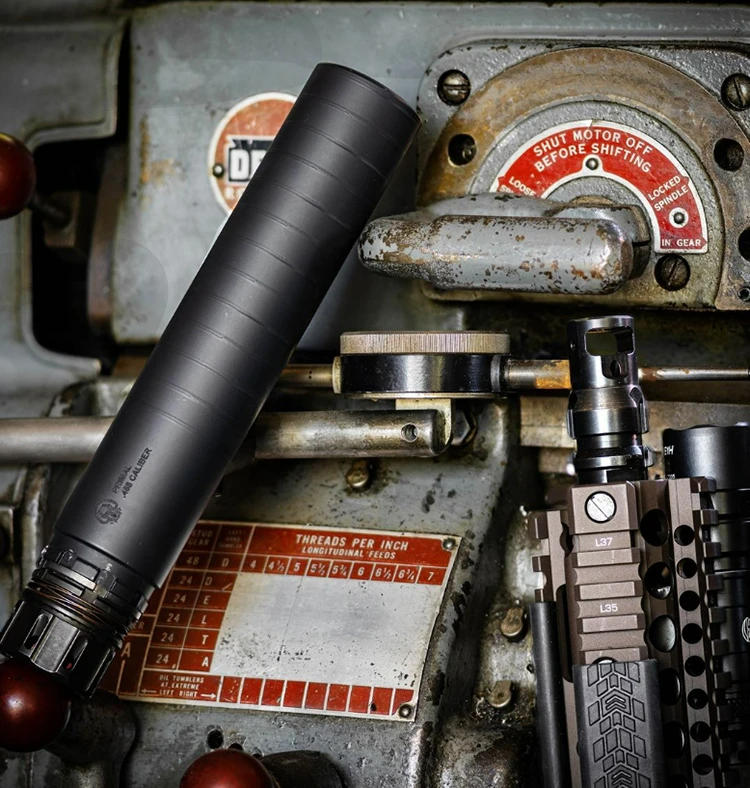

Do Threaded Barrels Affect Accuracy?
Your accuracy will be on par or improved while shooting a firearm with a threaded barrel because you will be able to shoot suppressed, and you’ll have more accurate follow-up shots due to reduced recoil.
Can You Thread a Barrel on a Pistol?
Yes, you can buy threaded pistol barrels. Note that a booster assembly may be required if you plan to attach a suppressor to your pistol. A booster assembly allows pistols with tilting barrels to be shot suppressed and still cycle properly.
What Does Having a Threaded Barrel Do?
A threaded barrel allows you to add attachments to your firearm to improve your shooting experience such as muzzle brakes, flash hiders, and silencers.
Do you need a threaded barrel for a silencer?
Yes, modern silencers require concentric barrel threads for proper installation.
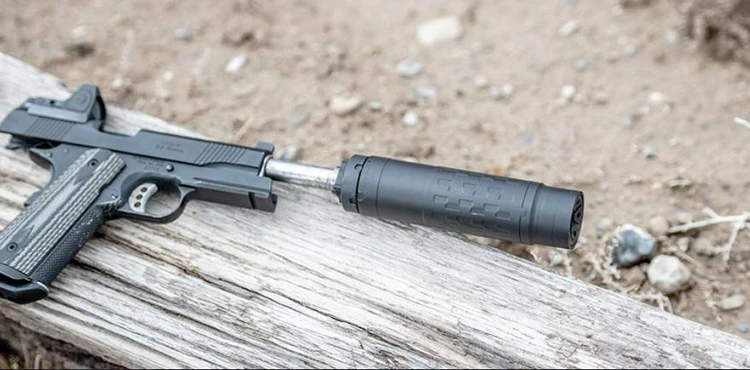

Photo credit: @SilencerCo
Final Thoughts
There are a multitude of benefits of having a threaded barrel, the primary reason being to be able to shoot suppressed. When choosing which threaded barrel is right for you, verify the thread pitch of the barrel and the device you’re going to mount. After determining compatibility, you can focus on the brand(s) that you trust, using manufacturer-provided details from the top-selling NFA brands such as SilencerCo, Sig Sauer, Griffin Armament, Daniel Defense, and more.
A threaded barrel is a critical upgrade that unlocks a world of customization for your firearm. By understanding what a threaded barrel does and the process behind rifle barrel threading, you can confidently enhance your weapon with devices like suppressors, compensators, and flash hiders. Whether you’re matching an AR thread pitch on an AR-15, verifying the 9mm thread pitch on your handgun, or ensuring your .45 ACP fits the standard 45 acp thread pitch, proper measurement and installation are key.
Additionally, being aware of legal considerations—such as what states are threaded barrels illegal—ensures that your modifications remain compliant with local laws. And if you’re wondering if you need a threaded barrel for a compensator, the answer is typically yes, as it provides a secure and standardized mounting surface for a variety of accessories.
Embracing the benefits of a threaded barrel not only improves your firearm’s performance by reducing recoil, muzzle blast, and flash, but it also provides a platform for personal customization and enhanced shooting accuracy. With careful attention to thread size, pitch, and proper maintenance, your threaded barrel setup will be a valuable asset for years to come.
